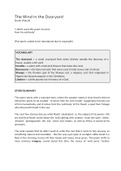Derek Walcott
“I didn't want this poem to come
from his salt body”
(Full poem unable to be reproduced due to copyright)
VOCABULARY
The dooryard > a small courtyard that exists directly outside the doorway of a
house, usually a dirt yard.
Coralita > a plant with small pink flowers that looks like coral.
Barracoons > old stone barracks that were used to hold slaves and criminals.
Shango > the thunder god of the Shango cult, a religious sect that originated in
Nigeria but became popular in the Caribbean.
Libation > a drink poured out in honour of a God.
STORY/SUMMARY
The poem starts with a reluctant tone, where the speaker makes it clear that he did not
intend the poem to be created - it comes from his ‘torn mouth’, suggesting it bursts out
of him involuntarily, and it comes from the ‘salt body’ of Eric Roach, a poet from Tobago
who drowned himself in the sea.
The next few stanzas discuss what Roach ‘celebrated’, i.e. the subject of his poems. We
are told that Roach wrote about the ‘wall spilling with coralita’, ‘clean dirt yard’, ‘ackee’,
‘almond’, ‘pomegranate’, the ‘sea’, ‘wind’ and ‘cedars’, as well as Africa, in search of his
ancestors.
The poet repeats that he didn’t want to write this, but that it came to him anyway, as
something natural and inevitable - like the way eyes open in sunlight, cattle stand in a
field in the morning, horses lift their heads and mules chew grass. The poem shifts to
more ominous imagery, sound based this time, the noises of ‘wild yams’, ‘broken
, windmills’ and the moss that grows over barracoons, old stone barracks that were
used to hold slaves and criminals.
It seems that the landscape reminds Walcott of Roach and his work, whether he tries
to remember him or not - the rain which is a libation to Shango, a thunder god, and the
sound of the wind in the dooryard, these experiences of living in the Caribbean
conjures up Roach for him.
The seventh stanza focuses on the pastoral image of a peasant, who is deeply
grounded in the Caribbean landscape. He spits out ‘pity’, perhaps for Roach’s death or
for the state of the Caribbean itself.
The poem concludes on an uplifting, positive tone, compressing images which
occurred in previous stanzas and ending on the smell of the ‘freshness of life’. We can
perhaps interpret this ending as a reconciliation of Walcott’s earlier criticisms of
Roach’s work, as well as his sadness about his death, concluding that as a literary
figure he had a positive impact on the world - particularly in terms of helping to create
a distinctly Caribbean identity.
SPEAKER/VOICE
The poem is written in a personal tone, using first person singular throughout to
provide Walcott’s thoughts and feelings on the death of his friend. Roach is the
subject of the poem, but as a subject he is approached abstractly. Instead of the
poem being a collection of memories of their time together, Walcott takes the
opportunity to bring the reader’s attention (directly addressed in the poem as ‘you’)
to Roach’s contributions to literature, specifically his importance in helping to define
a Caribbean identity in writing and art.
THEMES/IDEAS
● Caribbean life - the poem contains many references to the world which Roach
and Walcott shared, they grew up in the same culture and setting, therefore
sharing a lot of subject matter and themes.


